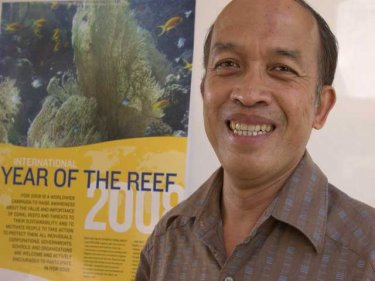THE INTERNATIONAL Year of the Reef 2008 is shaping as a key period in the struggle against cyanide fishermen, the Crown of Thorns starfish, the ignorant tourist, and a newly detected threat: the underwater photographer.
All are potentially destructive to Thailand's precious and relatively small but accessible reefs.
Dr Niphon Phongsuwan of the Phuket Marine Biological Centre has just returned from a multi-national gathering in Washington where the future of the world's delicate living underwater organisms was the main topic.
He says the Crown of Thorns, scourge of Australia's Great Barrief Reef, is now on the attack among Thailand's Andaman corals, too.
Outbreaks see large areas of coral bleached white as the beautiful mauve killers, which grow to up to 40 centimetres across, spread their extruded stomachs and suck the life from the reef.
The starfish, active at night, hide during the day and often leave only patches of white, dead coral to show they are populating in plague proportions.
Constant vigilance is essential.
The ignorant tourist often also attacks in plague proportions, and dead, broken coral is usually an indication of their presence.
As a gentleman scientist, Dr Niphon is far too polite to compare tourists with starfish suckers the way Phuketwan just did.
But he does say that the breed known as snorkellers are far more likely to cause irreparable damage to reefs than the more mature and sensible scuba-diver species.
And he warns of a relatively new type of threat that has only been detercted by marine biologists in the past few years: the underwater photographer.
Cheap waterproof cameras now mean that more of this breed are inclined to poke and prod coral, going too close and often breaking off pieces with their fins in the process.
They get the picture, but they kill the reef.
Politely, Dr Niphon says: ''They see a pretty subject and forget about their fins. They move the coral to get a nicer shot.''
Visitors who cannot swim are also a greater danger than those who can.
Floundering about in lifejacket and fins for the first time, an inexperienced snorkeller will panic as water enters a face mask and stand on coral out of fear.
Language is sometimes the biggest problem. Phuketwan has witnessed a visiting couple emerging from the water, delightedly showing off lumps of coral.
The couple, probably enjoying their honeymoon, did not understand Thai or English, or the rules of the reef.
Dr Niphon has not seen fresh reports saying that coral is so delicate that even too much sunscreen from divers may kill them, but he did say that in the Caribbean, creams and oils on divers are already banned.
This reef year's special activity to save the region's undersea beauty is the Green Fin Project covering Thailand, Indonesia and the Philippines, with Dr Niphon as project leader.
Green Fin aims to spread one main message: Do Not Touch the Coral. Although it is not easy, education may eventually get the message across.
People also have to learn that while feeding fish may be fun, it is usually damaging, too, Dr Niphon says.
Those fish leading the easy life might be the predators in the area who would otherwise eat the eggs of the Crown of Thorns starfish, helping to prevent a plague.
Dr Niphon acknowledged that Thailand has good laws aimed at protecting the reefs, but enforcing them is the constant struggle.
It's no trivial offence. Anyone taking coral can be fined up to 40,000 baht or jailed for four years.
But Dr Niphon says seaborne tour guides are under pressure to perform and deliver.
A visitor will say ''Well last year my friend came back with a chunk of coral. Why can't I?''
And at the end of the day, the guide wants that handy tourist tip.
''It's not easy to get the message across,'' Dr Niphon says. There is hope, however, as the message spreads.
Dr Niphon says that dynamite fishing and destruction caused by anchor-dropping are not so prevalent now.
Mooring buoys and greater vigilance seem to have cured those problems.
Periodic cold currents and global warming are two threats that are much harder to detect and perhaps impossible to prevent.
The Green Fins Project, with industry involvement and the backing of several generous sponsors, is expected to deliver many benefits, especially in awareness training, coral monitoring and reef health.
With luck, these may even include reducing the threat from the species known as the ignorant snorkeller and put an end to the underwater photographer plague.
GREEN FINS EVALUATION
Here's a handy checklist for divers who care:
How well did the dive operator adhere to Green Fins Friendly Diving and Snorkelling Guidelines and act as responsible role model for guests?
Did the dive operator use mooring buoys on every dive, when available?
Did the dive operator sell or allow others to sell corals and other marine life at the shop?
How well did the dive/boat operator deal with garbage and solid waste?
Did the dive/boat operator abide by all local, regional, national and international environmental laws, regulations and customs?
Did the dive operator provide guests with an explanation of Green Fins Friendly Diving and Snorkelling Guidelines in pre-dive briefings?
Did the dive operator provide other public awareness and environmental materials (books, pamphlets, fish ID books, etc.)?
Did the dive operator provide information on local marine protected areas, environmental rules and regulations?
Did the dive operator promote a strict No Touch policy for all reef diving and snorkeling?
E: info@greenfins-thailand.org greenfins@gmail.com www.greenfins-thailand.org
All are potentially destructive to Thailand's precious and relatively small but accessible reefs.
Dr Niphon Phongsuwan of the Phuket Marine Biological Centre has just returned from a multi-national gathering in Washington where the future of the world's delicate living underwater organisms was the main topic.
He says the Crown of Thorns, scourge of Australia's Great Barrief Reef, is now on the attack among Thailand's Andaman corals, too.
Outbreaks see large areas of coral bleached white as the beautiful mauve killers, which grow to up to 40 centimetres across, spread their extruded stomachs and suck the life from the reef.
The starfish, active at night, hide during the day and often leave only patches of white, dead coral to show they are populating in plague proportions.
Constant vigilance is essential.
The ignorant tourist often also attacks in plague proportions, and dead, broken coral is usually an indication of their presence.
As a gentleman scientist, Dr Niphon is far too polite to compare tourists with starfish suckers the way Phuketwan just did.
But he does say that the breed known as snorkellers are far more likely to cause irreparable damage to reefs than the more mature and sensible scuba-diver species.
And he warns of a relatively new type of threat that has only been detercted by marine biologists in the past few years: the underwater photographer.
Cheap waterproof cameras now mean that more of this breed are inclined to poke and prod coral, going too close and often breaking off pieces with their fins in the process.
They get the picture, but they kill the reef.
Politely, Dr Niphon says: ''They see a pretty subject and forget about their fins. They move the coral to get a nicer shot.''
Visitors who cannot swim are also a greater danger than those who can.
Floundering about in lifejacket and fins for the first time, an inexperienced snorkeller will panic as water enters a face mask and stand on coral out of fear.
Language is sometimes the biggest problem. Phuketwan has witnessed a visiting couple emerging from the water, delightedly showing off lumps of coral.
The couple, probably enjoying their honeymoon, did not understand Thai or English, or the rules of the reef.
Dr Niphon has not seen fresh reports saying that coral is so delicate that even too much sunscreen from divers may kill them, but he did say that in the Caribbean, creams and oils on divers are already banned.
This reef year's special activity to save the region's undersea beauty is the Green Fin Project covering Thailand, Indonesia and the Philippines, with Dr Niphon as project leader.
Green Fin aims to spread one main message: Do Not Touch the Coral. Although it is not easy, education may eventually get the message across.
People also have to learn that while feeding fish may be fun, it is usually damaging, too, Dr Niphon says.
Those fish leading the easy life might be the predators in the area who would otherwise eat the eggs of the Crown of Thorns starfish, helping to prevent a plague.
Dr Niphon acknowledged that Thailand has good laws aimed at protecting the reefs, but enforcing them is the constant struggle.
It's no trivial offence. Anyone taking coral can be fined up to 40,000 baht or jailed for four years.
But Dr Niphon says seaborne tour guides are under pressure to perform and deliver.
A visitor will say ''Well last year my friend came back with a chunk of coral. Why can't I?''
And at the end of the day, the guide wants that handy tourist tip.
''It's not easy to get the message across,'' Dr Niphon says. There is hope, however, as the message spreads.
Dr Niphon says that dynamite fishing and destruction caused by anchor-dropping are not so prevalent now.
Mooring buoys and greater vigilance seem to have cured those problems.
Periodic cold currents and global warming are two threats that are much harder to detect and perhaps impossible to prevent.
The Green Fins Project, with industry involvement and the backing of several generous sponsors, is expected to deliver many benefits, especially in awareness training, coral monitoring and reef health.
With luck, these may even include reducing the threat from the species known as the ignorant snorkeller and put an end to the underwater photographer plague.
GREEN FINS EVALUATION
Here's a handy checklist for divers who care:
How well did the dive operator adhere to Green Fins Friendly Diving and Snorkelling Guidelines and act as responsible role model for guests?
Did the dive operator use mooring buoys on every dive, when available?
Did the dive operator sell or allow others to sell corals and other marine life at the shop?
How well did the dive/boat operator deal with garbage and solid waste?
Did the dive/boat operator abide by all local, regional, national and international environmental laws, regulations and customs?
Did the dive operator provide guests with an explanation of Green Fins Friendly Diving and Snorkelling Guidelines in pre-dive briefings?
Did the dive operator provide other public awareness and environmental materials (books, pamphlets, fish ID books, etc.)?
Did the dive operator provide information on local marine protected areas, environmental rules and regulations?
Did the dive operator promote a strict No Touch policy for all reef diving and snorkeling?
E: info@greenfins-thailand.org greenfins@gmail.com www.greenfins-thailand.org




